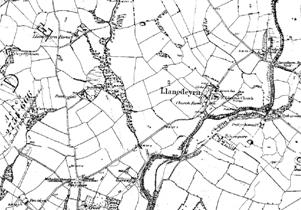THE HISTORY OF CARDIFF'S SUBURBS
LLANEDEYRN AND PENTWYN
CONTENTS
Tap or click to open / closeParish Foundations
Llanedeyrn was named after St. Edeyrn who was a sixth-century British prince. He travelled from Caerleon to Cardiff, and according to local traditional he built a church on the bank of the River Rhymney.
Source: OS
Like many Parishes in Cardiff at the time of the Normal occupation, St. Edeyrn's paid levies to Tewkesbury Abbey.
In 1236, these payments were transferred to Llandaff Cathedral. The Normans rebuilt the church and it was restored again in 1888.
Some of the original Normal stonework can still be seen.
Farming Community
Llanedeyrn was a typical rural community with a local economy based on farming. The Farms were surrounded by ancient woodland, the names of which live on in the road names, such as Coed-y-Gores.
Coed y Nant is now a park with a lake and a playing field. Pentwyn, Tyn-v-Parc, Malthouse and Llanedeyrn Farms were all owned by the Kemys-Tynte family of Cefn Mably, who rented them out to local tenants.
By the middle of the 19th Century, a Blacksmith, a Cobbler and a Thatcher were working in the hamlet. A days hard labour was rewarded by a visit to the Unicorn Inn. Originally a 14th Century farm house, the building was converted in the late 18th Century and is still serving customers today.
Because of its location on the estate's outskirts, The Unicorn was absorbed into the Old St. Mellons district, although historically, it should be in 'Old Llanedeyrn'. By the 1870's, Llanedeyrn had it's first school which was built on land in Pen-y-Groes, near Pen-twyn Farm.
The land on which it stood had been granted to the community by the Kemys-Tynte family, and education continued there for nearly 90 years.
Urbanisation
Parts of Llanedeyrn came under Cardiff's jurisdiction in 1889. The Kemys-Tynte Estate was broken up in 1921 and by 1967 the suburb had been fully absorbed into the City.
Once under the rule of the County Borough Council, the housing expansion began. This was facilitated by the need for extra homes for returning soldiers at the end of World War Two.
Several new schools were built and in 1974 the Maelfa Shopping Centre opened. The community benefitted from this rapid urbanisation with the introduction of a health centre, a nursing home, a library and a leisure centre.
Pentwyn
The newly created district of Pentwyn provided more land for housing and commercial properties, including one of the biggest leisure centres in Cardiff.
There was a need for a improved links with the rest of the City and soon after the construction of the Eastern Avenue the BUPA hospital opened.
The numerous car show rooms and hotels all benefitted from being a few minutes travel from the M4 motorway, bringing much needed employment to the local population.
PAGE UPDATE HISTORY
01 April 2024 (Content and coding updates)
01 December 2014 (Coding updates)
July 2009 (Page Created)

